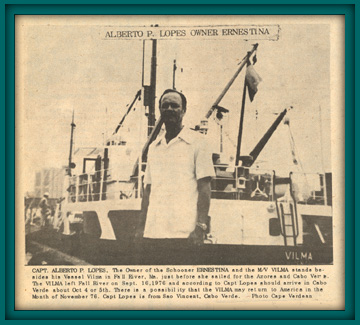|
The
Cape Verdean-American Ethnic Heritage Committee in
Providence wrote to the President of Cape Verde inquiring
whether it would be possible to send the Ernestina
to America for the Bi-centennial. The President replied
that he would ensure that everything possible would be
done for the Ernestina to participate in Operation
Sail 1976. The Ernestina was hauled; forty
shipwrights, welders, mechanics and riggers worked on the
vessel from seven am to seven pm for two weeks; a man was
sent to Lisbon for new sails; seaman who had sailed on
her and two students from the Mindelo Navigation School
were selected for her crew; all that could be done to
make her ready was undertaken. Only her masts (which had
already caused concern to the surveyor) could not be
replaced. A news article appeared in the New Bedford
Standard-Times on June 13, 1976:
Ernestina Research Ship
Sen. Edward Kennedy, D-Mass, has accepted the
honorary chairmanship of the "Save the
Morrissey" campaign, an effort to raise funds
for the restoration of the Effie M. Morrissey as a
research vessel....The vessel is scheduled to
participate in the "Tall Ships-Newport
‘76" program later this month in New port,
RI.
The Ernestina is now privately owned and
operated in the Cape Verde Islands off the coast of
West Africa. Because of its historical importance to
the United States, the owners have agreed to sell the
ship to the Bartlett Exploration Association, Inc.,
so that it may continue in scientific voyages first
pioneered by Capt. Bartlett. Following the "Tall
Ships" participation, the Ernestina is scheduled
to remain in the United States to be refitted as a
research and training vessel.
The United Nations, together with the Bartlett
Exploration Association and the Cape Verdean-American
Ethnic Heritage Committee, are raising funds to
support the program.
On June 11, 1976 the Ernestina set sail from
the wharf of Porto Grande, Sao Vicente-destination New
York for OpSail 1976. The captain was Marcos Lopes; first
mate, Belmiro Barros; motorman, Amaro Salamao. Around
midnight engine trouble developed. The motorman tried to
repair the broken motor pump while the Ernestina
continued sailing. He managed to get the engine running
again but at 4 am the pump again broke down. This was
confirmed by considerable increase of water in the
bilges.
At the same time it was noticed that the rigging on
the foremast was too slack so it was decided to head for
the closest port, Tarrafal de Monte Trigo, Santo Antao to
fix the engine and tighten the rigging. The wind picked
up and the sea became stormy, rocking the ship, tossing
the sails, stretching the rigging, breaking some
deadeyes, and causing the shrouds to become looser. They
dropped the foresail and lashed the boom in order to help
the foremast hold. They radioed the M/V Wilma
which was accompanying the Ernestina to come
closer to tow her to safe harbor. By 8 am it was apparent
the foremast was going to come down. Just as the crew was
attaching the towline, the foremast cracked, falling into
the sea taking with it the large mainmast with all the
sails. Since both masts were pounding against the side,
endangering the schooner, it was necessary to cut off all
the rigging, letting the new sails sink beneath the sea.
Fortunately no persons were lost or injured.
An article appeared in the Providence
Journal-Bulletin, June 22, 1976:
Verdean Schooner Damaged Heavy
winds off the Cape Verde Islands have toppled both
masts of the historic windjammer Ernestina,
shattering any hope of the ship’s participation
in Operation Sail in New York City July 4.
The dismasting occurred about six miles off the
coast of the island of Santo Antao just 10 hours
after the Ernestina set sail for the United States
June 11. Michael Platzer, a United Nations program
management officer for Cape Verde, said yesterday.
Platzer, who returned from Cape Verde last
weekend, said the storm destroyed the
Ernestina’s rigging and shredded $5,000 worth of
brand new sails which had been purchased in Lisbon
especially for the voyage.
No one was injured in the dismasting, he said.
Platzer said the ship carried 13 crewmen and two
cadets from the Cape Verdean navigation school in the
city of Mindelo on the island of Sao Vicente, which
is Ernestina’s homeport.
"No one is more heartbroken than the
people in Cape Verde," Platzer said.
The Ernestina was to have been the only known
African ship in the gala parade of sail up New York
Harbor on the United States 200th birthday.

After the dismasting in the Atlantic, the Friends of Ernestina/Morrissey
Committee lead by Laura Pires Houston was officially
launched in New York. At a meeting at the National
Maritime Historical Society (NMHS) in Brooklyn, about
forty-five people were in attendance. The officers and
members of the committee included U.S. Senators Edward W.
Brooke and Edward M. Kennedy along with Don Ramos, Chair
of the Cape Verdean-American Ethnic Heritage Committee,
Austin Colgate, veteran of Bartlett voyages, Tony Lopes,
Providence Corporation, and Michael Platzer, Office of
Technical Assistance, United Nations. Operating under the
auspices of the National Maritime Historical Society, the
Committee’s purposes were to: 1) create and maintain
local support-building structures 2) raise funds for Ernestina’s
restoration and return and 3) plan for her future use.
|